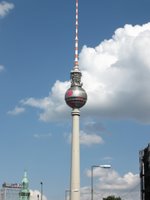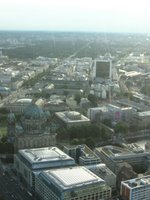After visiting the museums, my friends and I could not wait to see more history on the streets! My friends and I spent Monday 14th August 2006 wandering through the government district, pausing at Brandenburg Gate, visiting the World War II memorials (Jewish memorial and Führerbunker) before strolling along Unter den Linden up to Lustgarten. Then we took a boat ride along the river Spree and went up to the TV tower at the end of the day to get a good perspective of the whole city.
Berlin witnessed the come and go of the different eras. It used to be the capital city of the Prussian Empire, and the monarchs chose to leave their marks through the works along the central thoroughfare of Berlin, Unter den Linden (literally, under the lime trees). The modern-day Unter den Linden is bound in the east by the Lustgarten (Pleasure Garden) surrounded by the Museuminsel (Museum Island) and the Berliner Dom (Berlin Dome Church). The Prussian monarchs funded the museum collections and the expansion of the Berliner Dom, which is not only a place of worship but also contains a crypt at the basement for the royal family. Along the way to the west, we reached Bebelplatz where the State Opera and St. Hedwig’s Cathedral were located. Opposite to Bebelplatz was Humboldt University which produced many Nobel Laureates (but not the last 40 years!) and Berlin State Library. At the western end of the road was Pariser Platz (Square of Paris) and the Brandenburg Gate. The Gate used to mark the entry (and exit) point of Berlin during the Prussian days, but it is probably more famous as a symbol of a divided Germany after World War II.
The communists left a lasting architectural landscape in Berlin. Many residential buildings of that era were still standing in the eastern part of the city, in the form of rather dull looking high-rise buildings of 10 storeys or so. The TV tower at Alexanderplatz (Alexander Square) was meant to display the technological prowess of East Germany, and now it provides a good vantage point of the city. Berlin resumed its status as a capital city of a re-united Germany some years after the collapse of the communists. As one of the many symbols of unity, the two of new government buildings on opposite banks of river Spree (the section of Spree in today’s government district once separated East and West Berlin) are joined by a bridge. The government district is also home to the German Federal Parliament (the one with a glass dome at the top) and the Chancellor’s residence. Unfortunately, my friend and I did not enter the parliament building because we were scared by the long queue!
There is no escape from the memories of World War II in Berlin. But only more recently are the reminders so much starker with the completion of the Jewish memorial (which consists of a series of pillars, supposedly representing tombstones of the victims), the marking of the bunker (Führerbunker) where Hitler spent his last days, and the construction of the brand-new Sony Center. Such spanking new buildings actually speak of how much the War had destroyed the old Berlin, and architects around the world are keen to leave their impressions in this historical city which is also a big construction site!
參觀過博物館後,我和朋友當然要看柏林其他的歷史。8月14日那天,我們先到國會所在的政府區逛逛,然後瀏覽勃蘭登堡門、紀念二次大戰的猶太死難者紀念廣場及希特勒度過最後日子的地窖,再取道至菩提樹下大街,一直走到該街未端的歡樂花園,在那裡遊船河,遊罷便登上亞歷山大廣場的電視塔,全方位遊覽柏林。
柏林見證了不少歷史變遷,以前曾是普魯斯帝國之首都,歷任帝王都在市內的要道——菩提樹下大街(Unter den Linden)大興土林,今時今日的菩提樹下大街,東起歡樂花園(Lustgarten),由博物館島及柏林圓頂教堂(Berliner Dom)所包圍。現時博物館的收藏品,及圓頂教堂的擴建,皆有賴歷任帝王斥資。圓頂教堂不單祇是一座教堂,地庫還是皇室墓陵。從那裡向西行,不久便到比貝爾廣場(Bebelplatz),為國家歌劇院及聖赫德維希大教堂(Sankt-Hedwigskathedrale)所在地,對面有洪堡大學(Humboldt University)——六十年代及以前諾貝爾獎得主輩出——和國立圖書館。菩提樹下大街的最西端,就是巴黎廣場(Pariser platz)和勃蘭登堡門。勃蘭登堡門在普魯斯時代是進出柏林的城門之一,也是後來東、西德分隔的象徵,相信大家對後者不會太陌生吧。
前東德時代的痕跡,最顯而易見的就是當年建成的,那些大概十層高、設計單調的民居,而前東德的「代表作」,要算是座落於亞歷山大廣場(Alexanderplatz)的電視塔,當時興建之目的是要顯示其科技實力,時至今日電視塔則是俯瞰柏林的最佳地點。前東德政權倒台後數年,柏林恢復其首都地位,現時的政府區,當年被中間的史比利河(Spree)分隔成東、西柏林兩部分,在河兩畔新建的兩座政府大廈,由一座橋相連,其統一復合之意不言而喻。政府區也是德國國會及總理宮邸所在地,國會頂部乃一玻璃圓頂,在外面等進內長長的人龍,把我們參觀的念頭打消了。
柏林也有不少二次大戰的遺跡,而最新的幾個紀念設施,還令人對這段歷史勾起更鮮明的回憶,包括豎立了一排排象徵墓碑的柱子的猶太死難者紀念廣場,希特勒臨終前入住的地窖Führerbunker的標記牌,及簇新的索尼中心(Sony Center),新建築物背後,是一股建築熱,當年二次大戰帶來的破壞和廢墟,被今日的建築師和設計師看中,所以有人說,現在的柏林,就是個大建築地盤(工地)!
The Government District 政府區



Different views of the German Parliament: the back from afar (top left), a closer view of the back (top right) and the front entrance (left)
國會背面遠觀(左上)、背面近觀(右上)及正面(左)


The two government buildings near Parliament now linked by a bridge over the river Spree, viz. Paul Löbe House and Marie-Elisabeth Lüders House (the building on the left and right, respectively, in both photos). They are named after famous politicians of Germany.
國會附近的兩幢政府大廈,由兩名著名的議員Löbe及Lüders命名,現有一道橋橫跨史比利河的橋相連。

In memory of those who lost their lives while fleeing East Germany across the Spree
紀念由東德逃亡西德時命喪史比利河之亡魂

The German Basic Law (the constitution) inscribed on glass walls
寫在玻璃牆上的德國基本法(憲法)

The residence of German Chancellor
德國總理宮邸
Brandenburg Gate and surrounds 勃蘭登堡門及附近


The Brandenburg Gate (left) and the Strasse des 17 Juni outside the Gate (right)
勃蘭登堡門(左)及門外的六月十七大道(右)


Memorial to the murdered Jews of Europe 猶太死難者紀念廣場

The last days of Hitler
希特勒最後的日子


The Sony Center 索尼中心
Berliner Dom 柏林圓頂教堂




Unter den Linden 菩提樹下大街


State library (left) and the statue of Frederich the Great of Prussia outdie (right)
國立圖書館(左)及外面的普魯斯腓特烈大帝之人像(右)

St. Hedwig's Cathedral
聖赫德維希大教堂
Views along river Spree 沿史比利河景色


Left: St. Nicholas' Church; Right: History side by side - the Berlin City Library, the former East German Parliament (Palast der Republik, now being demolished) and Berliner Dom from left to right
左:聖尼古教堂、右:新舊交替中,從左至右為柏林市立圖書館、前東德國會(共和國宮,現正拆毀)及柏林圓頂教堂


Leisure by the river 偷得浮生半日閒


Mind your heads!
小心碰頭!


Left: Bode Museum; Right: Berlin Central Station, opened in time for the World Cup
左:波德博物館、右:柏林火車總站,趕及在世界盃前啟用
Views from the TV Tower 從電視塔俯瞰柏林



The TV Tower was decorated like a football for the World Cup.
電視塔因應世界盃而裝飾成足球。


 Frankfurter Allee, and a close up on the East German style buildings. The 'twin tower' is called Frankfurter Tor and can be seen in the top left picture when magnified.
Frankfurter Allee, and a close up on the East German style buildings. The 'twin tower' is called Frankfurter Tor and can be seen in the top left picture when magnified.
法蘭克福大道,及該處的東德特色建築。那座「雙子塔」名為法蘭克福門,放大鳥瞰圖(左上)後亦可見。


The Government District and Unter den Linden (the straight road in the right picture)
政府區及菩提樹下大街(右圖中筆直的大街)
Berlin witnessed the come and go of the different eras. It used to be the capital city of the Prussian Empire, and the monarchs chose to leave their marks through the works along the central thoroughfare of Berlin, Unter den Linden (literally, under the lime trees). The modern-day Unter den Linden is bound in the east by the Lustgarten (Pleasure Garden) surrounded by the Museuminsel (Museum Island) and the Berliner Dom (Berlin Dome Church). The Prussian monarchs funded the museum collections and the expansion of the Berliner Dom, which is not only a place of worship but also contains a crypt at the basement for the royal family. Along the way to the west, we reached Bebelplatz where the State Opera and St. Hedwig’s Cathedral were located. Opposite to Bebelplatz was Humboldt University which produced many Nobel Laureates (but not the last 40 years!) and Berlin State Library. At the western end of the road was Pariser Platz (Square of Paris) and the Brandenburg Gate. The Gate used to mark the entry (and exit) point of Berlin during the Prussian days, but it is probably more famous as a symbol of a divided Germany after World War II.
The communists left a lasting architectural landscape in Berlin. Many residential buildings of that era were still standing in the eastern part of the city, in the form of rather dull looking high-rise buildings of 10 storeys or so. The TV tower at Alexanderplatz (Alexander Square) was meant to display the technological prowess of East Germany, and now it provides a good vantage point of the city. Berlin resumed its status as a capital city of a re-united Germany some years after the collapse of the communists. As one of the many symbols of unity, the two of new government buildings on opposite banks of river Spree (the section of Spree in today’s government district once separated East and West Berlin) are joined by a bridge. The government district is also home to the German Federal Parliament (the one with a glass dome at the top) and the Chancellor’s residence. Unfortunately, my friend and I did not enter the parliament building because we were scared by the long queue!
There is no escape from the memories of World War II in Berlin. But only more recently are the reminders so much starker with the completion of the Jewish memorial (which consists of a series of pillars, supposedly representing tombstones of the victims), the marking of the bunker (Führerbunker) where Hitler spent his last days, and the construction of the brand-new Sony Center. Such spanking new buildings actually speak of how much the War had destroyed the old Berlin, and architects around the world are keen to leave their impressions in this historical city which is also a big construction site!
參觀過博物館後,我和朋友當然要看柏林其他的歷史。8月14日那天,我們先到國會所在的政府區逛逛,然後瀏覽勃蘭登堡門、紀念二次大戰的猶太死難者紀念廣場及希特勒度過最後日子的地窖,再取道至菩提樹下大街,一直走到該街未端的歡樂花園,在那裡遊船河,遊罷便登上亞歷山大廣場的電視塔,全方位遊覽柏林。
柏林見證了不少歷史變遷,以前曾是普魯斯帝國之首都,歷任帝王都在市內的要道——菩提樹下大街(Unter den Linden)大興土林,今時今日的菩提樹下大街,東起歡樂花園(Lustgarten),由博物館島及柏林圓頂教堂(Berliner Dom)所包圍。現時博物館的收藏品,及圓頂教堂的擴建,皆有賴歷任帝王斥資。圓頂教堂不單祇是一座教堂,地庫還是皇室墓陵。從那裡向西行,不久便到比貝爾廣場(Bebelplatz),為國家歌劇院及聖赫德維希大教堂(Sankt-Hedwigskathedrale)所在地,對面有洪堡大學(Humboldt University)——六十年代及以前諾貝爾獎得主輩出——和國立圖書館。菩提樹下大街的最西端,就是巴黎廣場(Pariser platz)和勃蘭登堡門。勃蘭登堡門在普魯斯時代是進出柏林的城門之一,也是後來東、西德分隔的象徵,相信大家對後者不會太陌生吧。
前東德時代的痕跡,最顯而易見的就是當年建成的,那些大概十層高、設計單調的民居,而前東德的「代表作」,要算是座落於亞歷山大廣場(Alexanderplatz)的電視塔,當時興建之目的是要顯示其科技實力,時至今日電視塔則是俯瞰柏林的最佳地點。前東德政權倒台後數年,柏林恢復其首都地位,現時的政府區,當年被中間的史比利河(Spree)分隔成東、西柏林兩部分,在河兩畔新建的兩座政府大廈,由一座橋相連,其統一復合之意不言而喻。政府區也是德國國會及總理宮邸所在地,國會頂部乃一玻璃圓頂,在外面等進內長長的人龍,把我們參觀的念頭打消了。
柏林也有不少二次大戰的遺跡,而最新的幾個紀念設施,還令人對這段歷史勾起更鮮明的回憶,包括豎立了一排排象徵墓碑的柱子的猶太死難者紀念廣場,希特勒臨終前入住的地窖Führerbunker的標記牌,及簇新的索尼中心(Sony Center),新建築物背後,是一股建築熱,當年二次大戰帶來的破壞和廢墟,被今日的建築師和設計師看中,所以有人說,現在的柏林,就是個大建築地盤(工地)!
The Government District 政府區



Different views of the German Parliament: the back from afar (top left), a closer view of the back (top right) and the front entrance (left)
國會背面遠觀(左上)、背面近觀(右上)及正面(左)


The two government buildings near Parliament now linked by a bridge over the river Spree, viz. Paul Löbe House and Marie-Elisabeth Lüders House (the building on the left and right, respectively, in both photos). They are named after famous politicians of Germany.
國會附近的兩幢政府大廈,由兩名著名的議員Löbe及Lüders命名,現有一道橋橫跨史比利河的橋相連。

In memory of those who lost their lives while fleeing East Germany across the Spree
紀念由東德逃亡西德時命喪史比利河之亡魂

The German Basic Law (the constitution) inscribed on glass walls
寫在玻璃牆上的德國基本法(憲法)

The residence of German Chancellor
德國總理宮邸
Brandenburg Gate and surrounds 勃蘭登堡門及附近


The Brandenburg Gate (left) and the Strasse des 17 Juni outside the Gate (right)
勃蘭登堡門(左)及門外的六月十七大道(右)


Memorial to the murdered Jews of Europe 猶太死難者紀念廣場

The last days of Hitler
希特勒最後的日子


The Sony Center 索尼中心
Berliner Dom 柏林圓頂教堂




Unter den Linden 菩提樹下大街


State library (left) and the statue of Frederich the Great of Prussia outdie (right)
國立圖書館(左)及外面的普魯斯腓特烈大帝之人像(右)

St. Hedwig's Cathedral
聖赫德維希大教堂
Views along river Spree 沿史比利河景色


Left: St. Nicholas' Church; Right: History side by side - the Berlin City Library, the former East German Parliament (Palast der Republik, now being demolished) and Berliner Dom from left to right
左:聖尼古教堂、右:新舊交替中,從左至右為柏林市立圖書館、前東德國會(共和國宮,現正拆毀)及柏林圓頂教堂


Leisure by the river 偷得浮生半日閒


Mind your heads!
小心碰頭!


Left: Bode Museum; Right: Berlin Central Station, opened in time for the World Cup
左:波德博物館、右:柏林火車總站,趕及在世界盃前啟用
Views from the TV Tower 從電視塔俯瞰柏林



The TV Tower was decorated like a football for the World Cup.
電視塔因應世界盃而裝飾成足球。


 Frankfurter Allee, and a close up on the East German style buildings. The 'twin tower' is called Frankfurter Tor and can be seen in the top left picture when magnified.
Frankfurter Allee, and a close up on the East German style buildings. The 'twin tower' is called Frankfurter Tor and can be seen in the top left picture when magnified.法蘭克福大道,及該處的東德特色建築。那座「雙子塔」名為法蘭克福門,放大鳥瞰圖(左上)後亦可見。


The Government District and Unter den Linden (the straight road in the right picture)
政府區及菩提樹下大街(右圖中筆直的大街)

Comments